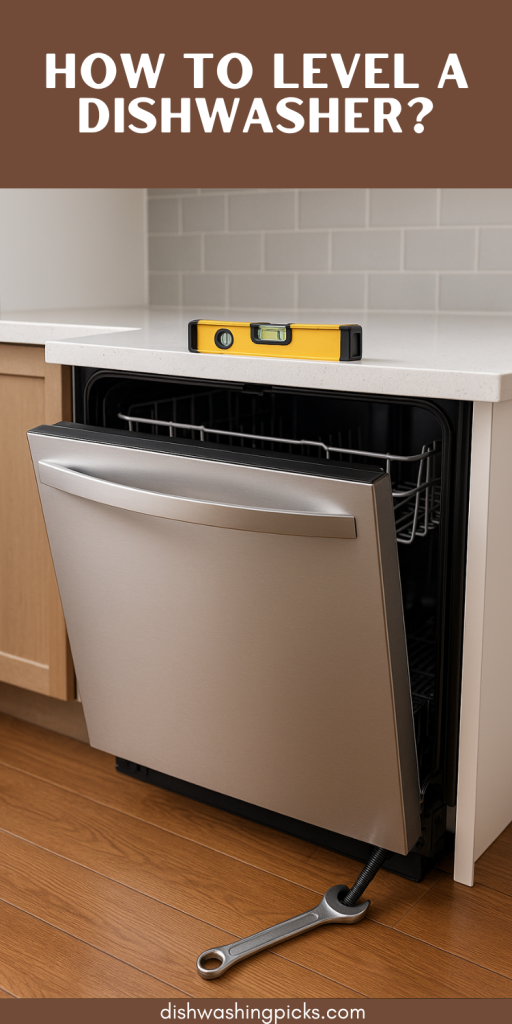
Ever noticed your dishwasher making weird noises or leaving puddles on the floor? Yeah, that might be your dishwasher throwing a tantrum because it’s not level. Imagine this: you set your dishwasher on a wobbly base, and suddenly your dishes don’t get cleaned properly or water pools where it shouldn’t. Not fun, right?
Leveling your dishwasher ensures it sits perfectly flat, which means water drains correctly, the door seals tight, and everything runs smoothly. Plus, it helps avoid damage over time. So, it’s worth spending a few minutes on this little adjustment.
Curious how to do it? Hang tight—we’ll break it down step by step next.
step-by-step leveling process
Step 1: Gather Your Tools (Not Much Needed, Promise!)
Before we dive in, grab these simple tools:
- A reliable level (the bubble kind or a digital one, whatever you’ve got)
- An adjustable wrench or pliers
- Maybe a flashlight if your dishwasher lives in a dim corner
That’s about it! No rocket science here.
Step 2: Check If Your Dishwasher Is Level
Open the dishwasher door and place your level on the bottom rack frame or the door itself (if sturdy enough). Check two directions:
- Side to side (left to right)
- Front to back
If the bubble is centered in both directions, congrats! Your dishwasher is level. If not, no worries—that’s why you’re here.
Step 3: Adjust the Legs
Most dishwashers have adjustable legs or feet at the front (and sometimes back). These legs can be turned clockwise or counterclockwise to raise or lower each corner.
Here’s how to do it:
- Find the legs at the bottom of your dishwasher.
- Turn the leg clockwise to lower that corner.
- Turn it counterclockwise to raise that corner.
- Adjust each leg little by little, checking the level after every tweak.
Pro tip: Some legs have a locking nut. Use your wrench or pliers to loosen the nut first, then adjust the leg, and tighten it back afterward to lock the leg in place.
Step 4: Test the Door Seal and Stability
Once leveled, gently close the dishwasher door:
- Does it latch easily without force?
- Does the door sit flush with the surrounding cabinetry?
- Give the dishwasher a slight shake—does it rock or feel steady?
If all looks good, you’re almost done! If not, fine-tune the legs again.
Step 5: Final Check and Celebrate!
Run a quick rinse cycle (no dishes needed) to see if water drains smoothly and no leaks appear. If everything’s dry and quiet, you nailed it!
Imagine this: your dishwasher running smoothly, no weird noises, no puddles, just perfectly clean dishes—and it all started with leveling.
Common Troubleshooting When Leveling Your Dishwasher
Dishwasher keeps rocking or feels unstable
If your dishwasher still wiggles after adjusting the legs, check if the floor underneath is uneven or if there’s debris blocking a leg. Sometimes placing a thin shim under a leg can help stabilize it.
Legs won’t turn easily
If the legs are stuck or hard to turn, spray a little WD-40 or lubricant on the threads and give it some time to soak. Use a wrench for better leverage, but don’t force it too hard.
Door won’t close properly after leveling
This might mean one side is still off or the dishwasher wasn’t pushed fully under the counter. Adjust the legs again, and gently push the dishwasher in until it fits snugly.
Why Is Leveling Such a Big Deal?
You might be wondering: “Is this really necessary?” Absolutely! A level dishwasher means:
- Proper water drainage (no standing water inside)
- Door seals correctly (no leaks on your floor)
- Smooth operation (less noise, fewer clanks)
- Longer lifespan for your machine (less stress on parts)
So yeah, it’s worth spending 10-15 minutes on this!
Bonus Tips for Specific Dishwasher Types
Built-in Dishwashers:
Usually have adjustable legs at the front, and sometimes sliders at the back. Take your time to slide it perfectly flush with cabinets.
Portable Dishwashers:
Often come on wheels, so leveling might involve locking the wheels and adjusting feet underneath.
Drawer Dishwashers:
Typically have less adjustment options but check the installation manual for any tweaks.
Wrapping It Up
So, there you have it — a friendly, no-fuss guide to leveling your dishwasher like a pro! Next time your dishes come out sparkling clean, remember, a little leveling love made it possible.
Feel free to ping me if you want help with other dishwasher quirks or installation hacks!
